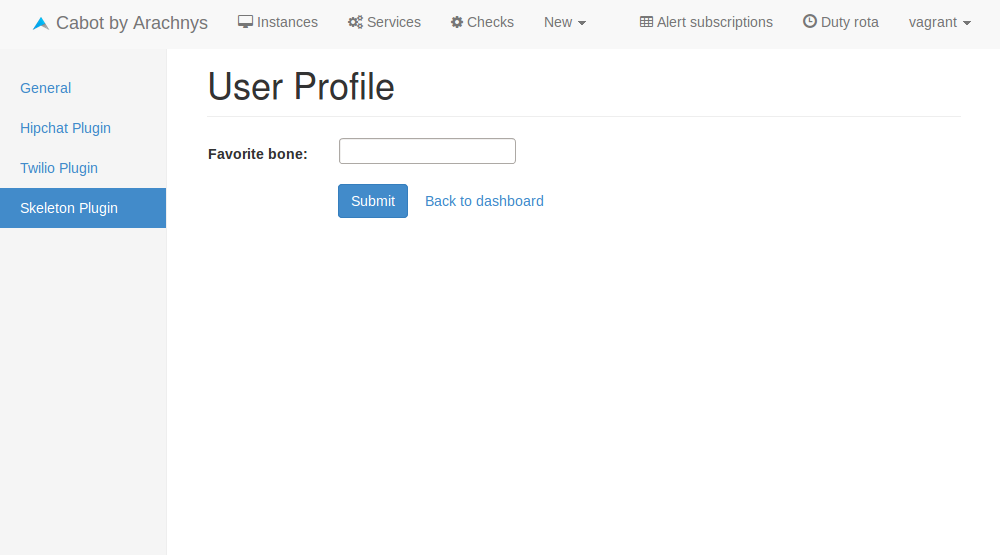Writing an Alert Plugin
With the release of cabot 0.0.1-dev, Cabot can now be extended through the use of alert plugins. This allows the user to be alerted of any service outages through any means of communication supported by the installed plugins. This tutorial will guide you through the process of writing a simple Cabot plugin.
Before getting started, follow the development introduction. Continue when you have set up docker-compose and got cabot running locally on your own machine.
You can obtain a ‘skeleton’ alert plugin which has all the necessary files to get started with cabot plugin development.
The cabot plugin architecture is designed to give the full power of django to the developer by getting out of his/her way as much as possible. For this reason it is necessary to understand the basics of how a django application works.
Layout
An alert plugin is essentially a small packaged django application and is organised as such.
cabot-alert-skeleton
├── cabot_alert_skeleton
│ ├── __init__.py
│ └── models.py
├── LICENSE
├── README.md
├── setup.cfg
└── setup.py
The root directory contains mostly meta-data, present in almost all python packages, about the plugin.
- LICENSE: Contains the license that the plugin is released under. Cabot is released under the MIT license.
- README.md: A README containing installation instructions and details about the plugin.
- setup.py: Installation script for the plugin. Fairly standard for a python package. Define your dependencies here.
- setup.cfg: Configuration file for the installation
The plugin code will all be contained inside the cabot_alert_skeleton subdirectory. Naturally you can name this however you wish however we suggest sticking to the naming convention cabot_alert_service where service is the means of communication i.e. email, twitter, hipchat etc.
As you would expect from a django application, the models.py file contains the models that define the functionality of the plugin.
The __init__.py file simply tells python that cabot_alert_skeleton is a module and defines the default imports.
When you have created, organised and configured your plugin, open up your models.py file.
Important Classes
When writing alert plugins for cabot, there are two classes that you may wish import:
from cabot.cabotapp.alert import AlertPlugin
from cabot.cabotapp.alert import AlertPluginUserData
These two classes are fairly self-descriptive. The AlertPlugin class defines a single discrete plugin and how the alert is carried out: i.e. sending a message to the user via Hipchat or sending them an email. The AlertPluginUserData is a model which defines any User preferences such as their hipchat alias. The AlertPluginUserData model is optional depending on whether you wish the user to be able to configure his/her preferences specifically for that plugin. Note that preferences such as the user’s name and email address are stored by Cabot under the user’s ‘General’ preferences and so do not need to be defined specifically by any one plugin.
It is a good idea to write the user preferences first because they shall be referenced in the AlertPlugin subclasses that you write.
AlertPluginUserData
The AlertPluginUserData class defines the preferences of a single user. Here is an example from the default skeleton alert plugin. As you can see, it is very simple.
from django.db import models
from cabot.cabotapp.alert import AlertPluginUserData
class SkeletonAlertUserData(AlertPluginUserData):
name = "Skeleton Plugin"
favorite_bone = models.CharField(max_length=50, blank=True)
The name variable dictates how the plugin will be referenced in the user preferences.
This section is out of date - Vagrant use is deprecated.
Once you have created your AlertPluginUserData subclass, you should test your plugin to make sure that it’s working. SSH into your vagrant box then install your plugin:
$ sudo pip install https+git://github.com/<your_user>/<your_plugin>.git

If Django throws an exception or you can’t see your plugin in the list:
- Make sure that there are no errors in your plugin.
- Make sure that you have installed it correctly.
AlertPlugin
The AlertPlugin class represents the actual plugin itself. It defines the name of the plugin, its author and the way that it handles an alert.
To get started, take a look at the AlertPlugin class from cabot-alert-skeleton
class SkeletonAlert(AlertPlugin):
name = "Skeleton"
author = "Jack Skellington"
def send_alert(self, service, users, duty_officers):
"""Implement your send_alert functionality here."""
return
The name and author are simply meta-data about your plugin. The ‘author’ field simple exists to give credit where it is due whereas the ‘name’ field is used when selecting plugins for a service.
- You should avoid using the word ‘plugin’ in the name in order to keep it short and simple. Everything is a plugin so there is no need to relay redundant information.

The send_alert function will be called whenever a service goes into a failing state and every 10 minutes after when it is still failing. The function will also be called when the service recovers and returns to a passing state.
- You can change the time in between alert notifications by setting the ALERT_INTERVAL value in your configuration file (normally conf/production.conf).